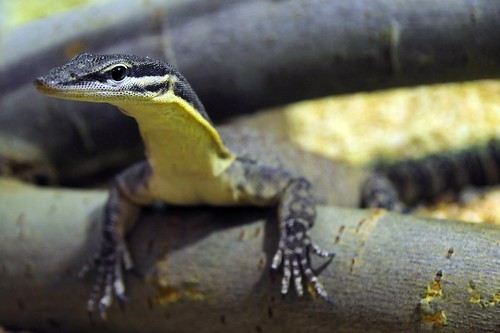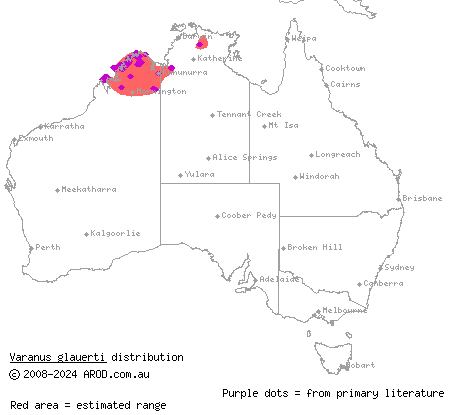Post by Ceratodromeus on Dec 6, 2016 9:31:13 GMT 5

Scientific classification
Kingdom: Animalia
Phylum: Chordata
Subphylum: Vertebrata
Class: Reptilia
Order: Squamata
Suborder: Lacertilia
Family: Varanidae
Genus: Varanus
Subgenus: Odatria
Species: V.glauerti
Description
Varanus glauerti is a mid sized, elongated species of the Odatria subgenus. It can be found in sympatry with the black palmed monitor(V.glebopalma), but is easily distinguished from the former species via its distinctive coloration. The species is variable in terms of coloration, with some populations possessing a more brilliant coloration than others{1}. Adults tend to have a dark dorsal coloration with earth toned patterning, which can vary from banding to large ovals running to approximately the vent region. In an overview study on the morphology of West Australian varanids, the mean snout-vent length of a sample containing 28 animals was 199.6mm(7.8in), presumably containing both sexes; the largest snout-vent measurement provided in this study was 239mm(9.4in){2}. Varanoid lizards of the world gave the average snout-vent length for males at 215mm(8.4in) and a mass of 95g(3.3oz), whilst females were stated to have an average snout-vent length of 180mm(7in) and weigh 60g(2.1oz){3}. Its elongated morphology, most noticeable in the neck and tail(which typically is around 1.8x the SVL measurement{3}), may be tied to its more arboreal lifestyle, as they prefer more vertical habitats.

Geographic distribution & Habitat use
This species is endemic to Western Australia, as well as the Northern Territory. Studies on the Kimberly rock monitor indicate it has a preference for more vertical habitats, such as Plateaus, rocky escarpments, and rocky outcrops. Sam Sweet's observations on this species in on study locale indicate that it has a preference for Allosyncarpia trees, after noosing one particular animal on the trunk of this tree he began to scout the canopy and was rewarded with the sight of many in the canopy, as well as on the trunks, during his stay in this locality{1}. Habitat segregation between this species and V.glebopalma appears to be present, with V.glauerti preferring more vertical outcrops -- though there is probably some degree of overlap. Sam Sweet observed one male V.glebopalma follow a male V. glauerti at a distance of 10 meters as it traveled through the formers' territory{1}. Intraspecific territory overlap appears to be common, with no real signs of antagonistic interactions outside of the mating season{3}.

Dietary habits
The Kimberly rock monitor is an actively foraging opportunistic predator. Where it displays more arboreal tendencies, it can commonly be observed foraging around the limbs and hollows of Allosyncarpia trees, where they find their preferred prey, large carnivorous katydids and geckos(Gehyra){1}. One overview article report Orthopterans and spiders were the most important prey animals recovered from 29 V.glauerti, also noting lizards, cockroaches, and caterpillars being consumed{4}.
Reproductive ecology
For both sexes, sexual maturity is attained at around 150mm(5.9in) in snout-vent length. Reproductive animals have been found from June to October, with most being found in August according to one effort from 1992{5}. Clutch size is relatively small, typically numbering three{5}. Field observations on courtship and mating in this species are very scarce(if even recorded), but a captive pair that was introduced in late 2009 gave insights into the habits of the species{6}. Courtship & mating was documented in January of 2010; It consisted of the male making persistent attempts at approaching the female, with rapid tongue flicking behavior. At first the female wasn't receptive, but became so after several days of insistence. Copulation was observed repeatedly over a few days. Within a week, Distension of the stomach(a sign of successful fertilization), increased food consumption, and digging in the substrate was noted from the female. Around a month after copulation was observed, the female laid her clutch( c.a. February 22nd, 2010), which numbered eight; three other clutches were laid by this female in ensuing months, they numbered four, nine, and three. All clutches were removed for artificial incubation. Eggs were incubated in perlite at a temperature of 28.5-29.5°C(83.3-85.1° F). The incubation period lasted between 104-110 days, depending on the clutch. From 20 eggs, 18 hatched successfully; the young measured 56-67mm(2.2-2.6in) in Snout-vent length, and weighed 2.3-4.2g(0.08-0.14oz){6}.

References
{1} Pianka, Eric R., and Samuel S. Sweet. "Field Observations by Two American Varanophiles."
{2} Thompson, Graham G., and Philip C. Withers. "Comparative morphology of western Australian varanid lizards (Squamata: Varanidae)." Journal of Morphology 233.2 (1997): 127-152.
{3} Pianka, Eric R., Dennis King, and Ruth Allen King. Varanoid lizards of the world. Indiana University Press, 2004.
{4}Losos, JONATHAN B., and HARRY W. GREENE. "Ecological and evolutionary implications of diet in monitor lizards." Biological Journal of the Linnean Society 35.4 (1988): 379-407.
{5} Lyneham, Australian Capitol, and Storer Hall. "Reproductive Biology and Diets of Goannas (Reptilia: Varanidae) from Australia."
{6} DE ZEEUW, M. A. R. T. I. J. N. "Husbandry and Reproduction of Varanus glauerti in Captivity." Biawak 4.3 (2010): 103-107.


